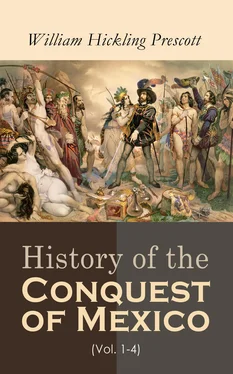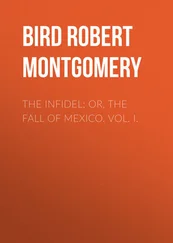At a suitable age for marrying, or for entering into the world, the pupils were dismissed, with much ceremony, from the convent, and the recommendation of the principal often introduced those most competent to responsible situations in public life. Such was the crafty policy of the Mexican priests, who, by reserving to themselves the business of instruction, were enabled to mould the young and plastic mind according to their own wills, and to train it early to implicit reverence for religion and its ministers; a reverence which still maintained its hold on the iron nature of the warrior, long after every other vestige of education had been effaced by the rough trade to which he was devoted.
To each of the principal temples, lands were annexed for the maintenance of the priests. These estates were augmented by the policy or devotion of successive princes, until, under the last Montezuma, they had swollen to an enormous extent, and covered every district of the empire. The priests took the management of their property into their own hands; and they seem to have treated their tenants with the liberality and indulgence characteristic of monastic corporations. Besides the large supplies drawn from this source, the religious order was enriched with the first-fruits, and such other offerings as piety or superstition dictated. The surplus beyond what was required for the support of the national worship was distributed in alms among the poor; a duty strenuously prescribed by their moral code. Thus we find the same religion inculcating lessons of pure philanthropy, on the one hand, and of merciless extermination, as we shall soon see, on the other. The inconsistency will not appear incredible to those who are familiar with the history of the Roman Catholic Church, in the early ages of the Inquisition. [119]
The Mexican temples— teocallis , “houses of God,” as they were called [120]—were very numerous. There were several hundreds in each of the principal cities, many of them, doubtless, very humble edifices. They were solid masses of earth, cased with brick or stone, and in their form somewhat resembled the pyramidal structures of ancient Egypt. The bases of many of them were more than a hundred feet square, and they towered to a still greater height. They were distributed into four or five stories, each of smaller dimensions than that below. The ascent was by a flight of steps, at an angle of the pyramid, on the outside. This led to a sort of terrace, or gallery, at the base of the second story, which passed quite round the building to another flight of stairs, commencing also at the same angle as the preceding and directly over it, and leading to a similar terrace; so that one had to make the circuit of the temple several times, before reaching the summit. In some instances the stairway led directly up the centre of the western face of the building. The top was a broad area, on which were erected one or two towers, forty or fifty feet high, the sanctuaries in which stood the sacred images of the presiding deities. Before these towers stood the dreadful stone of sacrifice, and two lofty altars, on which fires were kept, as inextinguishable as those in the temple of Vesta. There were said to be six hundred of these altars, on smaller buildings within the enclosure of the great temple of Mexico, which, with those on the sacred edifices in other parts of the city, shed a brilliant illumination over its streets, through the darkest night. [121] [122]
From the construction of their temples, all religious services were public. The long processions of priests, winding round their massive sides, as they rose higher and higher towards the summit, and the dismal rites of sacrifice performed there, were all visible from the remotest corners of the capital, impressing on the spectator’s mind a superstitious veneration for the mysteries of his religion, and for the dread ministers by whom they were interpreted.
This impression was kept in full force by their numerous festivals. Every month was consecrated to some protecting deity; and every week, nay, almost every day, was set down in their calendar for some appropriate celebration; so that it is difficult to understand how the ordinary business of life could have been compatible with the exactions of religion. Many of their ceremonies were of a light and cheerful complexion, consisting of the national songs and dances, in which both sexes joined. Processions were made of women and children crowned with garlands and bearing offerings of fruits, the ripened maize, or the sweet incense of copal and other odoriferous gums, while the altars of the deity were stained with no blood save that of animals. [123]These were the peaceful rites derived from their Toltec predecessors, on which the fierce Aztecs engrafted a superstition too loathsome to be exhibited in all its nakedness, and one over which I would gladly draw a veil altogether, but that it would leave the reader in ignorance of their most striking institution, and one that had the greatest influence in forming the national character.
Human sacrifices were adopted by the Aztecs early in the fourteenth century, about two hundred years before the Conquest. [124]Rare at first, they became more frequent with the wider extent of their empire; till, at length, almost every festival was closed with this cruel abomination. These religious ceremonials were generally arranged in such a manner as to afford a type of the most prominent circumstances in the character or history of the deity who was the object of them. A single example will suffice.
One of their most important festivals was that in honor of the god Tezcatlipoca, [125]whose rank was inferior only to that of the Supreme Being. He was called “the soul of the world,” and supposed to have been its creator. He was depicted as a handsome man, endowed with perpetual youth. A year before the intended sacrifice, a captive, distinguished for his personal beauty, and without a blemish on his body, was selected to represent this deity. Certain tutors took charge of him, and instructed him how to perform his new part with becoming grace and dignity. He was arrayed in a splendid dress, regaled with incense and with a profusion of sweet-scented flowers, of which the ancient Mexicans were as fond as their descendants at the present day. When he went abroad, he was attended by a train of the royal pages, and, as he halted in the streets to play some favorite melody, the crowd prostrated themselves before him, and did him homage as the representative of their good deity. In this way he led an easy, luxurious life, till within a month of his sacrifice. Four beautiful girls, bearing the names of the principal goddesses, were then selected to share the honors of his bed; and with them he continued to live in idle dalliance, feasted at the banquets of the principal nobles, who paid him all the honors of a divinity.
At length the fatal day of sacrifice arrived. The term of his short-lived glories was at an end. He was stripped of his gaudy apparel, and bade adieu to the fair partners of his revelries. One of the royal barges transported him across the lake to a temple which rose on its margin, about a league from the city. Hither the inhabitants of the capital flocked, to witness the consummation of the ceremony. As the sad procession wound up the sides of the pyramid, the unhappy victim threw away his gay chaplets of flowers, and broke in pieces the musical instruments with which he had solaced the hours of captivity. On the summit he was received by six priests, whose long and matted locks flowed disorderly over their sable robes, covered with hieroglyphic scrolls of mystic import. They led him to the sacrificial stone, a huge block of jasper, with its upper surface somewhat convex. On this the prisoner was stretched. Five priests secured his head and his limbs; while the sixth, clad in a scarlet mantle, emblematic of his bloody office, dexterously opened the breast of the wretched victim with a sharp razor of itztli ,—a volcanic substance, hard as flint,—and, inserting his hand in the wound, tore out the palpitating heart. The minister of death, first holding this up towards the sun, an object of worship throughout Anahuac, cast it at the feet of the deity to whom the temple was devoted, while the multitudes below prostrated themselves in humble adoration. The tragic story of this prisoner was expounded by the priests as the type of human destiny, which, brilliant in its commencement, too often closes in sorrow and disaster. [126]
Читать дальше












